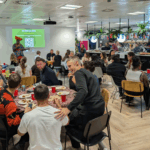Lucy Sicks speaks to Alex Voskou.
Authentic. That’s the first word that comes to mind as Lucy Sicks, founder of LIFEbeat, introduces herself to our People and Culture team and Wellbeing and Engagement committee.
Then, right on cue, she uses the word twice within the first few seconds: “Our young people are authentic,” she says. “We’re authentic in everything we do.” There’s no arguing with that, I think to myself.
The pandemic was difficult for all of us, but it was brutal for young people stuck indoors and deprived of their principal emotional, social and creative outlets. Equally, LIFEbeat was prevented from doing what it does best, at a time when it was needed most. But they’re more than making up for lost time, with their creative, mentoring and wellbeing programmes now fully up and running.
How LIFEbeat was born
It’s been 15 years since Lucy founded LIFEbeat. It might initially seem that working with young people is a bit of a jump from an English Literature degree and a career in the arts, but for Lucy, it was the natural convergence of several factors.
“Before LIFEbeat, I was the Director of the London Arts Fair,” she explains. “I have a big creative background, and the role was about creating community in the arts scene. Then I reached a crossroads – I could go on to develop another type of art fair or do what I really wanted to do and work with people. That’s why I retrained as a therapist.”
Lucy’s work in the arts led her to American treatment models, which “used creativity to help young people express themselves, connect with their souls and understand the purpose, the beauty and the depth of life.” While teaching at therapy college, Lucy discovered how young people need safe communities where they can tell stories and connect with each other. Then she met Charlie Murphy, who ran camps in the States – and yes, the rest is history. “We set up LIFEbeat together to hold those camps and create a UK-adapted community for young people. They brought together the creativity piece, the arts piece and the therapy piece, which through experience I think makes the difference.”
Co-create to accumulate
For Lucy, this courageous new venture ticked off the social, psychotherapeutic and creative boxes. “We believe in exploring our inner life through creativity and play,” she says. “And it works. Education’s standard of output is not about creativity, but we believe creativity is crucial to illuminate learning. Young people don’t just need to be taught about climate change and regeneration, for example, but to be inspired to find solutions. Not everyone is a fit for everything. Not everyone is hugely academic – that’s just how we are as human beings. It’s important when working with creativity and play to be conscious of that. If we work with creativity, we’re always learning and our values are enriched all the time.”
The mental health narrative is often about the individual, which, Lucy feels, makes it harder for us to recognise and understand other people’s challenges. To her, creativity’s not just an outlet for an individual sitting in front of a canvas, writing pad or computer screen and creating something that’s beautiful in a personal way. It also helps us to understand each other’s differences and facilitates collaboration.
“If it’s witnessed with empathy and kindness by their peers and they feel safe to do so, young people can tell their stories,” Lucy explains. “This allows them to appreciate that everyone has a story. The connection is extraordinary. Everyone has an imagination; everyone can come up with an idea. A two-minute conversation with a colleague, if you’re working well together, will help you come up with a better idea than you would on your own. The imagination to generate an idea, make stuff happen, co-create is very important, and our world needs it.”
Lucy and her team are now trying to bring LIFEbeat’s creative methodologies into classrooms. Katrina Hagan, Leadership and Organisational Development Coach and part of our Wellbeing and Engagement committee, wonders how they’re going about this. “It starts with the adults being authentic,” says Lucy – and there’s that word again. “Being comfortable with their own creativity.
Training can help teachers become more inspired in themselves and hold deeper level conversations with young people. People are happier when they feel they belong. Schools are places where they could feel this, but it needs a change. The reason I’ve been doing this for 15 years is we get results. It’s about psychological and emotional safety.”
Social media: a double-edged sword?
It’s difficult to have a conversation about young people’s mental health without talking about social media. Kate Graham, Functional Lead, is keen to understand how the growth of social media has contributed to the rising diagnoses of mental health problems in young people and what we can do to counter this.
“We believe in the power of digital detox,” says Lucy. “We ask the young people to give in their devices at the start of a session, so they can be fully present, and their connectivity’s not elsewhere. Life in social media can be polarised, for both the positive and negative. Body confidence, eating disorders, self-harm, online bullying, peer pressure; all the normal developmental things young people might go through are exaggerated on social media. It can also be a source of great connectivity and positivity, as well as access to information. There needs to be a pause. The discrepancy between how things look on the outside to how they are is a challenge to how we do things – to our focus on what’s inside. Everyone has an inner world of hopes, feelings, fears, dreams.”
Mind your language
Does social media make it harder than ever to be a young person? “One of the biggest burdens on young people right now is the constant narrative about problems rather than solutions – and they’re the ones with the energy to find them. It’s an adult rather than children’s issue, which is projected onto them. It’s very difficult for young people, but I always see things through the lens of hope; I don’t think staying in the problem is helping them.”
Perhaps the solution is to reframe how we talk about life’s challenges. “Don’t call it climate anxiety, for example – give them the agency, tools and inspiration to be the change in small ways. We need to listen to what they truly feel behind the narratives of anxiety, depression and burden. It needs to be positive. If we use the words ‘mental health,’ the focus needs to be ‘health’ and how we work towards that. It doesn’t duck the difficult stuff, but it’s about hope and what we’re going to do.”
Tune in and help out
If we see a young person who’s struggling in some way, how do we approach them and provide support? Subtly, Lucy says. “In our programmes, they’re given the chance to communicate. For example, they might do something in theatre improv that shows something’s going on. They’re put into small ‘family’ groups, and we work with therapeutic practices called check-ins, where we ask them to give us three feeling words. We just let them take their time. Every staff member’s primary purpose is to be a mentor. It’s not about asking intrusive questions which make them feel unsafe but building a therapeutic alliance through being interested. If they have issues like bullying at school or they’re struggling with mental health, we will do something about that, referring them to CAMHS (Child and Adolescent Mental Health Services) or addressing it with their school.”
“Outside LIFEbeat, it’s about getting alongside, being interested, listening, even just being in company. Teenagers have a veneer of ‘don’t come near me,’ but I’ve learnt from personal experience that that’s not how they feel on the inside. We do it through shared experience, getting alongside and combining that with a chat in a room to find out how they’re doing. They need that trust and rapport. The power of the group can work as it builds peer empathy as well as one-to-one empathy. Focus on relationships and communities young people can trust and relate to, because then they hopefully feel less lost and unhappy. It’s crucial just being caring and being curious, working on their terms.”
It’s good to talk
At The IN Group, we offer trained mental health first aiders and various programmes organised by our Wellbeing and Engagement committee, such as tea and talk sessions. These give us the opportunity to connect and talk about whatever we want. Providing these initiatives is all very well, but how do we encourage people to come forward and – if they need it – seek support and guidance? Lucy feels that we’re going about it in the right way.
“Create a culture where an element of disclosure is normal like we do through check-in practices. We sometimes use metaphors to encourage young people to talk about something difficult. We might ask, ‘If how you feel was a weather pattern, what would it be?’ A feeling often accompanying depression is shame. It’s an innate feeling. If we’re overwhelmed with grief, we feel shame and often don’t ask for help. Regular check-ins should be a normalised practice – talking about what we’re grateful for, having an appreciation for each other.”
Which brings us nicely to our partnership. It’s clear that what drew us to LIFEbeat wasn’t just a desire to make a difference but a genuine synergy in the way we look at the world. “These days,” Lucy says, “you abandon yourself and speak with a polish. But life’s about connecting with other people. The young people we work with are speaking in their own way, a way that’s true to them.”
Lucy happily recalls the moment she overheard a LIFEbeat youngster remarking to one of their peers, “You should talk to Lucy. She’s alright, you know.” It seems mirroring their young people’s authenticity is working pretty well for Lucy and her team.
Share this:




